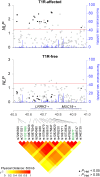A Missense LRRK2 Variant Is a Risk Factor for Excessive Inflammatory Responses in Leprosy
- PMID: 26844546
- PMCID: PMC4742274
- DOI: 10.1371/journal.pntd.0004412
A Missense LRRK2 Variant Is a Risk Factor for Excessive Inflammatory Responses in Leprosy
Abstract
Background: Depending on the epidemiological setting, a variable proportion of leprosy patients will suffer from excessive pro-inflammatory responses, termed type-1 reactions (T1R). The LRRK2 gene encodes a multi-functional protein that has been shown to modulate pro-inflammatory responses. Variants near the LRRK2 gene have been associated with leprosy in some but not in other studies. We hypothesized that LRRK2 was a T1R susceptibility gene and that inconsistent association results might reflect different proportions of patients with T1R in the different sample settings. Hence, we evaluated the association of LRRK2 variants with T1R susceptibility.
Methodology: An association scan of the LRRK2 locus was performed using 156 single-nucleotide polymorphisms (SNPs). Evidence of association was evaluated in two family-based samples: A set of T1R-affected and a second set of T1R-free families. Only SNPs significant for T1R-affected families with significant evidence of heterogeneity relative to T1R-free families were considered T1R-specific. An expression quantitative trait locus (eQTL) analysis was applied to evaluate the impact of T1R-specific SNPs on LRRK2 gene transcriptional levels.
Principal findings: A total of 18 T1R-specific variants organized in four bins were detected. The core SNP capturing the T1R association was the LRRK2 missense variant M2397T (rs3761863) that affects LRRK2 protein turnover. Additionally, a bin of nine SNPs associated with T1R were eQTLs for LRRK2 in unstimulated whole blood cells but not after exposure to Mycobacterium leprae antigen.
Significance: The results support a preferential association of LRRK2 variants with T1R. LRRK2 involvement in T1R is likely due to a pathological pro-inflammatory loop modulated by LRRK2 availability. Interestingly, the M2397T variant was reported in association with Crohn's disease with the same risk allele as in T1R suggesting common inflammatory mechanism in these two distinct diseases.
Conflict of interest statement
The authors have declared that no competing interests exist.
Figures




Similar articles
-
Pleiotropic effects for Parkin and LRRK2 in leprosy type-1 reactions and Parkinson's disease.Proc Natl Acad Sci U S A. 2019 Jul 30;116(31):15616-15624. doi: 10.1073/pnas.1901805116. Epub 2019 Jul 15. Proc Natl Acad Sci U S A. 2019. PMID: 31308240 Free PMC article. Clinical Trial.
-
Association of TNFSF8 regulatory variants with excessive inflammatory responses but not leprosy per se.J Infect Dis. 2015 Mar 15;211(6):968-77. doi: 10.1093/infdis/jiu566. Epub 2014 Oct 15. J Infect Dis. 2015. PMID: 25320285
-
Association of the LRRK2 genetic polymorphisms with leprosy in Han Chinese from Southwest China.Genes Immun. 2015 Mar;16(2):112-9. doi: 10.1038/gene.2014.72. Epub 2014 Dec 18. Genes Immun. 2015. PMID: 25521227
-
Quantitative assessment of the effect of LRRK2 exonic variants on the risk of Parkinson's disease: a meta-analysis.Parkinsonism Relat Disord. 2012 Jul;18(6):722-30. doi: 10.1016/j.parkreldis.2012.04.013. Epub 2012 May 8. Parkinsonism Relat Disord. 2012. PMID: 22575234 Review.
-
Leprosy susceptibility: genetic variations regulate innate and adaptive immunity, and disease outcome.Future Microbiol. 2011 May;6(5):533-49. doi: 10.2217/fmb.11.39. Future Microbiol. 2011. PMID: 21585261 Review.
Cited by
-
Regulation of myeloid cell phagocytosis by LRRK2 via WAVE2 complex stabilization is altered in Parkinson's disease.Proc Natl Acad Sci U S A. 2018 May 29;115(22):E5164-E5173. doi: 10.1073/pnas.1718946115. Epub 2018 May 14. Proc Natl Acad Sci U S A. 2018. PMID: 29760073 Free PMC article.
-
LRRK2 maintains mitochondrial homeostasis and regulates innate immune responses to Mycobacterium tuberculosis.Elife. 2020 Feb 14;9:e51071. doi: 10.7554/eLife.51071. Elife. 2020. PMID: 32057291 Free PMC article.
-
LRRK2 and Parkinson's disease: from genetics to targeted therapy.Ann Clin Transl Neurol. 2023 Jun;10(6):850-864. doi: 10.1002/acn3.51776. Epub 2023 Apr 6. Ann Clin Transl Neurol. 2023. PMID: 37021623 Free PMC article. Review.
-
A genome wide association study identifies a lncRna as risk factor for pathological inflammatory responses in leprosy.PLoS Genet. 2017 Feb 21;13(2):e1006637. doi: 10.1371/journal.pgen.1006637. eCollection 2017 Feb. PLoS Genet. 2017. PMID: 28222097 Free PMC article.
-
Is LRRK2 the missing link between inflammatory bowel disease and Parkinson's disease?NPJ Parkinsons Dis. 2021 Mar 9;7(1):26. doi: 10.1038/s41531-021-00170-1. NPJ Parkinsons Dis. 2021. PMID: 33750819 Free PMC article. Review.
References
-
- Organization WH. Global leprosy update, 2014: need for early case detection. Wkly Epidemiol Rec. 2015;90(36):461–74. . - PubMed
-
- Lienhardt C, Fine PE. Type 1 reaction, neuritis and disability in leprosy. What is the current epidemiological situation? Lepr Rev. 1994;65(1):9–33. . - PubMed
-
- Fava V, Orlova M, Cobat A, Alcais A, Mira M, Schurr E. Genetics of leprosy reactions: an overview. Mem Inst Oswaldo Cruz. 2012;107 Suppl 1:132–42. Epub 2013/01/11. doi: S0074-02762012000900020 [pii]. . - PubMed
Publication types
MeSH terms
Substances
Grants and funding
LinkOut - more resources
Full Text Sources
Other Literature Sources
Medical

